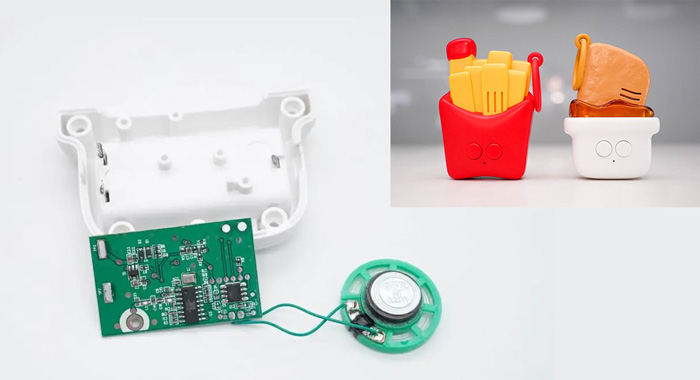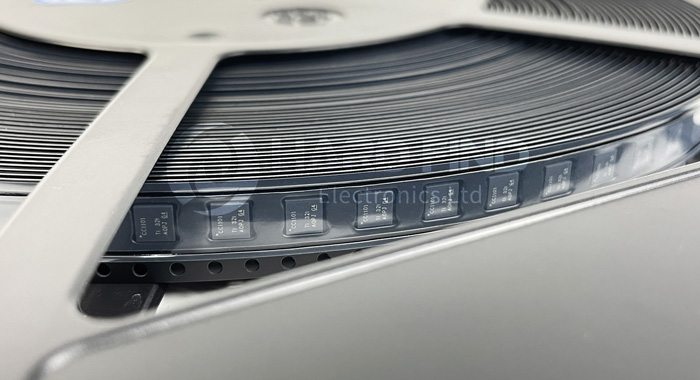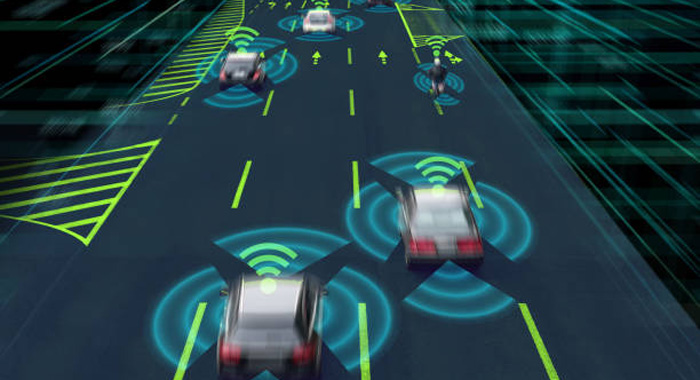Global digitization is driving the development of wireless communication technologies, such as cellular 4G/5G, WiFi, and Ultra-Wideband (UWB). Radio Frequency (RF) transmission technology has made the world more interconnected. The demand for RF products across different industries and applications is also gradually increasing. Devices supported by RFIC have become an indispensable part of daily life.

Source from Internet
Recently, McDonald's limited-edition toy walkie-talkies launched on Children's Day attracted young guys to rush for purchase, with prices even inflated to 300 yuan on the resale market. This public walkie-talkie can communicate within a range of 300 meters. However, setting aside its unique design and brand effect, its internal motherboard only costs 1.5 yuan. Among them, the electronic component that plays a role in wireless communication is BK4802, the radio frequency transceiver.
What is RFIC?
Radio Frequency Integrated Circuits (RFIC) contains a power amplifier, low noise amplifier, wireless switch, filter, frequency generator, and other circuits. It receives radio signals through an antenna and converts them into certain radio signal waveforms, then sent out through antenna resonance.
RFIC is an integrated circuit specially used for processing radio frequency signals. Its operating frequency range is from 300KHz to 300GHz, covering the most active frequency bands in the field of wireless communication such as high frequency, very high frequency, and ultra-high frequency. With the improvement of IC technology since the mid-1990s, RFIC has emerged as a new type of device.
Filter: The filter removes signals in a specific frequency band, including bandpass filters (BPF) that allow a specific frequency range to pass, low-pass filters (LPF) that allow frequencies below a specific frequency to pass, and high-pass filters (HPF) that allow frequencies above a specific frequency to pass.
Modulator/Demodulator: The modulator encodes the signal in a way that meets the communication channel requirements. It can act as an "up-converter" in the transmitter, where a low-frequency analog signal is combined with a local oscillator signal to generate an RF signal. The demodulator extracts the signal carrying the original information from the modulated carrier for decoding.
Amplifier: The low-noise amplifier amplifies weak signals and filters noise responses. The power amplifier is used to amplify the output of the mixer to a higher power for transmission. The higher the transmission efficiency, the wider the coverage.

CC1101RGPR RF Transceiver ICs for Ultra Low-power Wireless Applications
Application of RFIC
Radio Frequency was first used in wireless broadcasting (FM/AM). With the continuous iteration of RF transmission technology, the design of RF circuits has become more complex and needs to be integrated into ultra-large system-on-chip (SoC) solutions. RFIC is an important driving force for the development of wireless communication technology. It improves the performance and efficiency of wireless communication systems through integrated design and plays a vital role in achieving effective wireless communication, sensing, and network connectivity.
RF and wireless products are widely used in communications, radar, navigation, radio broadcasting, satellite communications, and other fields. Especially in the field of mobile communications, RFIC is used to process the RF front end to support wireless communication standards such as LTE and 5G. In addition, RFIC is also one of the key components for the widespread application in automobiles, healthcare, information, and technology.
Internet of Things (IoT)
RFIC applications in the IoT cover multiple fields such as item tracking and management, intelligent transportation, intelligent medical care, and intelligent manufacturing.
RFID (Radio Frequency Identification) technology is a key component for item tracking and management in the IoT. For example, in logistics and supply chain management, it can track the location, status, and transportation process of goods, and improve the visibility and transparency of logistics and transportation. In the medical industry, it can be used for patient identification, drug tracing, and medical device management.
In intelligent transportation systems, RFIC is used for vehicle identification, ETC systems, and traffic information collection, which improves traffic efficiency.
With the continuous development of the IoT, RFIC technology will also be more widely used in emerging fields such as agriculture and environmental protection. RFID technology can be used for garbage sorting, environmental monitoring, etc., providing more scientific data support for environmental protection work.
As the core of wireless communication technology, RFIC provides reliable data collection and transmission functions for IoT devices.
Radio and TV Broadcasting
The application of RFIC in the field of radio and TV broadcasting mainly involves the emission, reception, transmission, distribution and processing of signals. Through the precise control and processing of RFIC, the stability and reliability of broadcast signals can be ensured, and high-quality audio and video services can be provided.

Source from Internet
RFIC is used to modulate, amplify and transmit radio frequency signals in radio broadcast transmitters to ensure that the broadcast signals can cover the target area. In radio receiving equipment, RFIC is responsible for receiving and demodulating these radio frequency signals and restoring them to the original audio signals for users to listen to.
In TV broadcasting, MRFIC is not only used for signal transmission and reception, but also involves signal transmission and distribution. With the development of digital TV, TV broadcasting supports more channels and higher image quality. RFIC can process these complex signals and ensure the stable transmission of multiple channels. In TV broadcasting, RFIC is responsible for modulating digital signals into radio frequency signals for transmission, and demodulating radio frequency signals into original digital signals at the receiving end for decoding and display.
Automotive Electronics
RFIC is widely used in automotive electronics, including wireless communication, radar detection, vehicle identification and monitoring, etc.
RFIC is the critical component of the familiar Bluetooth, WiFi, and 4G/5G mobile communications, which allows automotives to communicate wirelessly with external devices. Information sharing and exchange are achieved through RFIC in the interior of the car, such as entertainment systems, safety systems, and infotainment systems.
As user demand increases, automotive electronics are becoming more and more intelligent. Auxiliary functions such as reversing radar, adaptive cruise control, and collision warning usually use RFIC to receive radio frequency signals and determine the distance, speed, and direction of objects by measuring the propagation time and frequency changes of the signal.

Source from Internet
RFID technology realizes automatic identification and data exchange of vehicle identity through wireless radio frequency signals and is widely used in vehicle identification, vehicle tracking, and parking management.
RFIC is used in tire pressure monitoring systems (TPMS) to monitor the internal air pressure and temperature of tires in real-time and transmit data to the vehicle's central control system. This helps drivers detect tire abnormalities promptly and improve driving safety.
In addition, it can also realize the functions of wireless access control and remote control switches. RFIC is driving automotive electronics towards higher performance, more intelligent, safer, and more reliable development.
Infineon is one of the leading semiconductor manufacturers in the field of automotive electronics. With leading SiGe BiCMOS, RF bulk silicon, and RF SOI CMOS technologies, it provides high-performance, energy-saving, and green RF solutions for the RF complexity and technical challenges of the new era. Infineon RFIC is widely used in automotive wireless communications and automotive radars such as ADAS.
Navigation and Radar
In navigation systems, RFIC is responsible for receiving and processing radio frequency signals from satellites to ensure that GPS devices can accurately provide location, speed, and time information. In radar systems, RFIC plays a particularly prominent role, especially in automotive radars, which are used to transmit and receive signals. For example, 77GHz RFIC can provide high-resolution and anti-interference radar detection, which is widely used in advanced driver assistance systems (ADAS) such as collision avoidance, adaptive cruise control, and parking assistance.

Source from Internet
In addition, it is also used in weather radar, aviation, and marine radar equipment. RFIC provides important support for the safety and intelligence of modern transportation systems.
Wireless Sensor Networks
Wireless sensor networks include environmental monitoring, smart agriculture, and industrial automation applications. Wireless connections between sensor nodes eliminate the need for a great amount of wiring and infrastructure. RFIC applications can provide flexibility and scalability because it is easy to expand or reconfigure RFIC-based networks.
In addition, RFIC has the advantages of wide coverage, high data transmission rate, and efficient signal processing. It can be used for tasks such as signal amplification, frequency conversion, and modulation in satellite communication systems.
Conclusion
With the continuous development of wireless communication technology, the market needs more sophisticated RFIC.
With the booming development of IoT technology, RFIC will pay more attention to energy efficiency and extended battery life to support a wide range of applications from smart homes to industrial automation. Secondly, RFIC integrated with artificial intelligence (AI) and machine learning technology will also become a major trend. It can use AI algorithms to perform complex tasks such as spectrum sensing and adaptive modulation to improve the efficiency and intelligence of wireless communication systems.
Technological innovation will drive RFIC to develop in the direction of high frequency, high speed, and low power consumption to meet the growing demand for high-performance and cost-effective solutions. With the popularization of new-generation communication technologies such as 5G and 6G, RFIC will achieve wider and more efficient wireless connections worldwide, further promoting the development of the information society.